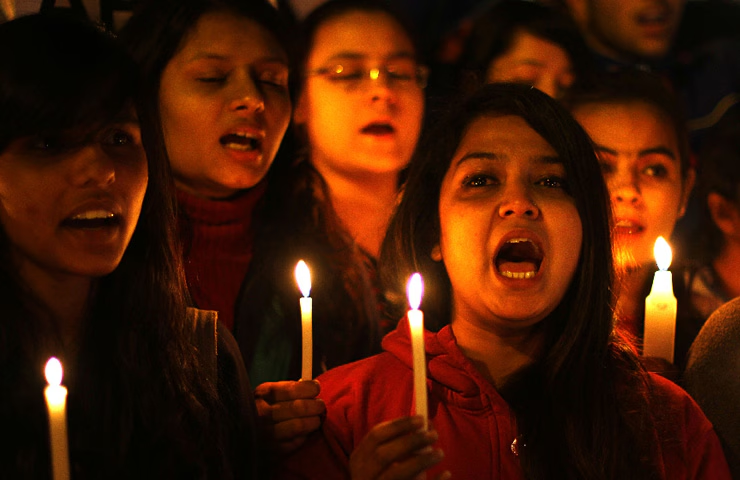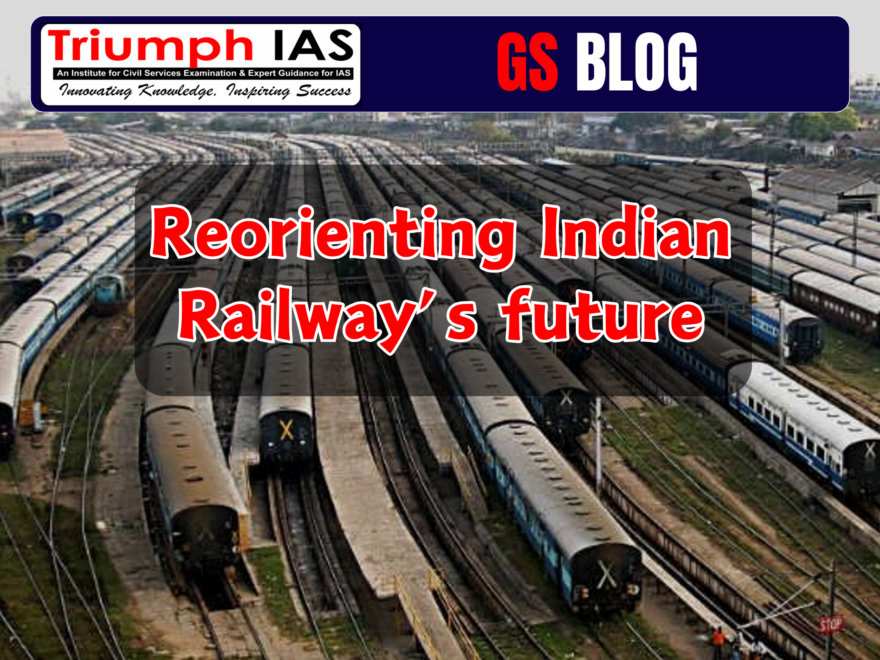Reorienting Indian Railway’s future
Indian Railways, which operates the world’s fourth-largest rail network, is struggling to maintain its dominance in India’s transportation sector. Although the rail network’s route kilometers and track length have increased since 1950, its share in freight transport has sharply declined from 85% in 1951 to less than 30% by 2022. This decline presents a significant challenge to India’s net-zero goals and efforts to decarbonize the transport sector. The National Rail Plan aims to reverse this trend by increasing the rail share in freight transport to 45% by 2030-31, with an ambitious target of 3,600 million tonnes of freight loading.
However, performance indicators for the railways highlight some troubling trends. Growth rates in both passenger and freight movement have slowed, particularly during the Twelfth Five-Year Plan (2012-13 to 2016-17), signaling a disconnection between GDP growth and traffic performance. To meet its ambitious goals, Indian Railways needs to revamp its business strategies, diversify revenue streams, and address capacity limitations and service quality issues.

Significance of Railways for India
- Economic Backbone: Indian Railways is crucial to India’s economic development, serving as a key link in the supply chain. In 2022-23, it transported 1,512 million tonnes of freight, contributing significantly to industrial and agricultural growth. The introduction of Dedicated Freight Corridors (DFCs) is expected to reduce logistics costs by using higher axle load trains.
- Driver in Achieving India’s Climate Goals: As India works towards its Nationally Determined Contribution (NDC) target of reducing emission intensity of GDP by 45% from 2005 levels by 2030, Indian Railways plays a key role in sustainable transportation. Rail transport is far more energy-efficient than road transport, generating less than one-fifth of the greenhouse gas emissions of road freight per ton-kilometer. Shifting more freight from road to rail could make a significant contribution to India’s climate objectives.
- Affordable Mobility: Indian Railways acts as a social equalizer, offering affordable transportation to millions of Indians. Its revenue from the passenger segment saw a 73% increase during April-January 2023. The railways’ tiered pricing system ensures that people across different economic groups have access to transportation.
- Bolstering National Security and Integration: Indian Railways is crucial for national security and integration, enabling rapid mobilization of troops and equipment to border areas. Projects like the Bilaspur-Manali-Leh rail line are strategically important, providing all-weather connectivity to the Ladakh region. Additionally, railways promote national unity by fostering cultural exchange and tourism, as seen in initiatives like the Bharat Gaurav trains that showcase India’s heritage.
- Urban Lifeline: Railway-based urban transport systems are reshaping Indian cities. Over the last decade, 700 km of new metro lines have been made operational, bringing the total length to 945 km and extending metro services to 21 cities. These systems play a vital role in sustainable urban development, easing traffic congestion and reducing air pollution. For example, the Delhi Metro, which carries about 6.5 million passengers daily, has significantly reduced CO2 emissions. Integrating metro systems with other transport modes is enhancing urban mobility.
- Bridging the Urban-Rural Divide: Indian Railways acts as a catalyst for regional development, particularly in remote areas. Projects like the Northeast Frontier Railway’s expansion have boosted economic activities in previously isolated regions. The completion of the 111 km Jiribam-Imphal railway line, for example, will transform Manipur’s connectivity and economy. Such projects not only improve transport but also support development in education, healthcare, and local industries, helping to bridge the urban-rural divide.
Major Issues Related to Indian Railways
- Declining Modal Share in Freight Transport: Indian Railways has seen a sharp decline in its share of freight transport, dropping from 85% in 1951 to under 30% in 2022. This trend undermines India’s environmental goals and the efficiency of its transport sector. The National Rail Plan aims to boost rail’s freight share to 45% by 2030-31, but current forecasts suggest this goal may not be met. For instance, even with a projected 7% compound annual growth rate (CAGR), freight loading is expected to reach only 2,598 million tonnes (MT) by 2030-31, far short of the 3,600 MT target. This decline points to broader issues of competitiveness and an inability to adapt to evolving economic and transport needs.
- Financial Performance and Operating Ratio: Indian Railways’ financial condition has deteriorated, as reflected by its worsening operating ratio (OR). The OR, which stood at a low of 78.7% in 2006-07, surpassed 100% in 2021-22, meaning the railways are spending more than they earn. The Comptroller and Auditor General of India has raised concerns that the reported OR does not fully reflect the true financial situation. For example, in 2019-20, if actual pension expenditures were accounted for, the OR would have been 114.35%, not the reported 98.36%, showing a deeper financial strain.
- Over-Reliance on Coal for Revenue: Indian Railways is heavily dependent on coal transport, which accounted for 47% of freight earnings in 2021-22. As India transitions towards renewable energy, this reliance presents a significant risk. The Ministry of Power’s directive in January 2023 to adopt the “Rail-Ship-Rail” model for coal transport in certain states may further reduce coal-related revenues. The lack of diversification in freight revenue leaves Indian Railways vulnerable to energy policy changes and market shifts, threatening its long-term financial stability.
- Capacity Constraints and Infrastructure Limitations: Despite increasing its running track length from 51,315 km in 1950-51 to 102,831 km in 2021-22, Indian Railways faces significant capacity limitations. These constraints hamper its ability to meet rising transport demand and compete with other modes of transport. The slow pace of network expansion has contributed to the decline in the railway’s share of freight transport, particularly in bulk commodities like cement. Even with price inelasticity, rail’s share in cement transport fell between 2005-06 and 2019-20, indicating that capacity and service quality, not just pricing, are influencing customer decisions.
- Technological Adaptation Lag: Indian Railways struggles with technological modernization and adapting to market needs. For example, container services account for only 12% of freight loading and have seen little growth. This indicates a lag in adapting to emerging freight sectors like automotive. Additionally, the implementation of “Kavach,” an automated train protection system designed to prevent collisions, has been slow. Four years after its introduction, it has been installed on just 1,456 km of the South Central Railway, covering only 3% of the national rail network.
- Safety Concerns and Derailments: Indian Railways continues to face safety challenges, particularly derailments. The average number of consequential train accidents between 2018 and 2023 was 44 annually. Incidents like the Balasore triple train crash in June 2023 and the Sabarmati Express derailment in August 2024 highlight on going vulnerabilities. Factors such as out dated infrastructure, human error, and signal failures contribute to these accidents, making the goal of “zero accidents” elusive. Continued investment in track renewals, modern signaling systems, and improved safety protocols is essential.
- Slow Progress in High-Speed Rail Projects: India’s ambitious high-speed rail initiatives, such as the Mumbai-Ahmadabad bullet train project, have faced significant delays and cost overruns. Initially slated to be operational by 2023, the completion date has been postponed to 2028 due to land acquisition issues. These delays impede India’s progress in modernizing its rail infrastructure, affecting its competitiveness on the global stage and stalling long-term economic growth.
- Human Resource Management and Skill Gaps: As one of the world’s largest employers, Indian Railways faces considerable challenges in human resource management and skill development. The modernization of operations, such as the introduction of semi-high-speed Vande Bharat trains, requires specialized skills in maintenance and operations. According to the Union Railway Minister, over 2.50 lakh posts were vacant as of July 2023. Filling these vacancies while ensuring the workforce is equipped with the necessary skills for modern railway operations is a significant challenge.
What can be done to revitalize Indian Railway sector?
- Implement Advanced Traffic Management Systems:
Indian Railways should expedite the deployment of advanced traffic management systems, such as Kavach, across its network. This automated train protection system can greatly enhance both safety and operational efficiency. Expanding Kavach beyond its current 1,456 km coverage to at least 20% of the rail network over the next two years could substantially reduce the risk of collisions. Priority should be given to high-traffic corridors and accident-prone areas. Furthermore, integrating Kavach with AI-powered predictive maintenance tools could identify potential track or signal failures, improving safety and minimizing downtime.
- Diversify Freight Portfolio and Enhance Logistics Services:
To decrease its reliance on coal transport and adjust to evolving market needs, Indian Railways must focus on diversifying its freight portfolio. This includes developing specialized services for high-value, time-sensitive goods such as pharmaceuticals, electronics, and perishables. Creating a network of temperature-controlled containers and dedicated express freight corridors could attract new clients in these sectors. Additionally, partnering with e-commerce companies to design rail-based logistics solutions would allow Indian Railways to tap into the rapidly growing online retail market.
- Accelerate High-Speed and Semi-High-Speed Rail Projects:
While addressing delays in the Mumbai-Ahmedabad bullet train project, Indian Railways should also focus on expanding its semi-high-speed network, such as the Vande Bharat trains. This expansion should be supported by upgrading existing tracks and signaling systems to handle higher speeds. For example, modernizing the Golden Quadrilateral rail network to consistently support speeds of 160-200 km/h could significantly reduce travel times on major routes, making rail transport more competitive with air travel for intercity journeys.
- Develop Sustainable and Energy-Efficient Operations:
Indian Railways should hasten its transition to renewable energy and energy-efficient technologies. Increasing track electrification to 100% and expanding solar and wind power generation along railway lines would significantly enhance sustainability. For example, installing solar panels on station rooftops and unused railway land could generate a large portion of the railways’ energy requirements, helping to reduce its carbon footprint.
- Modernize Freight Terminals and Develop Multimodal Logistics Parks:
Indian Railways should focus on modernizing its freight terminals and establishing new multimodal logistics parks to improve efficiency and attract more freight traffic. This would involve automating loading and unloading operations, implementing advanced inventory management systems, and enhancing intermodal connections. The logistics parks should feature advanced container handling equipment, real-time tracking systems, and integrated customs clearance facilities, providing comprehensive logistics solutions.
- Enhance Station Redevelopment and Commercial Utilization:
The station redevelopment program should be accelerated to transform key railway stations into world-class transit hubs and commercial centers. Beyond cosmetic upgrades, these redevelopments should include smart city features, mixed-use developments, and improved passenger amenities. The redevelopment of Rani Kamlapati Railway Station in Bhopal, with its modern design, airport-like facilities, and emphasis on sustainability, serves as a model for future station projects.
Revamping Indian Railways is essential for strengthening its contribution to India’s economy and sustainability. Addressing issues such as the declining freight share and financial instability through modernization and innovative strategies will improve operational efficiency and competitiveness. Efforts like service diversification and station redevelopment will greatly enhance national integration and foster sustainable development, solidifying Indian Railways’ role as a central force in driving India’s future growth.
The End of the Blog: Reorienting Indian Railway’s future

|



















One comment